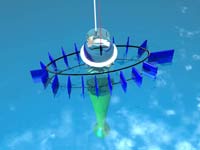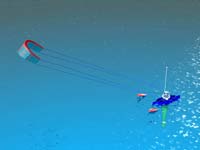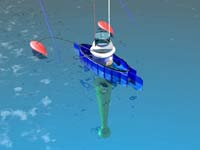| 
Ultra-Microcruisers with an Attitude
OCEANIC PENCIL
Second design for trans-oceanic smallness
design by Chris Ostlind
In Part One of this exercise in smallness, I presented the concept of “going under” for the slow ride across the pond to England. In Part Two I will actually address a conceptually feasible approach to the technical question of how short can a boat be and still satisfy the needs of a conscious sailor who wishes to cross the Atlantic ocean.
I was looking hard at the various tiny boats that have crossed the Atlantic over the years and they seem to have gotten smaller to the point of the absurd. I previously mentioned Hugo Vihlen’s record setting boat, Father’s Day at 5’4” from 1993. It was pretty obvious to me that his boat had been measured to 5’4” in order to just whisker under the boat length of his ultra-micro crossing rival, Tom MacNally who had just performed the same feat in his boat, Vera Hugh, that was 5’4.5”, also in 1993.
 |
I was looking hard at the various tiny boats that have crossed the Atlantic over the years and they seem to gotten smaller to the point of the absurd.
(click images for larger views) |
|
MacNally rallied his forces to produce an even shorter boat in 1998, the Vera Hugh II that measured an astoundingly short 3’11” for a go at the record. Apparently that boat did make the journey from Portugal to the Canaries, but for some reason, has not actually been put in the water for the big jump across the Atlantic to the Caribbean. As far as I know, she still sits in storage in the Canaries, waiting for her suitor to ride her to victory.
That means the door is wide open for a memorable, record setting design to splash down off Labrador and be swept to the enchanting Isles of Great Britain in the loving arms of the Gulf Stream.
Coincidentally, I have just the design to do both tasks, though it does require a bit of creative interpretation of the apparent rules in order to truly get a boat down to those sizes for this trip.
When you look at the Vera Hugh II in photos, what you see is essentially a floating, untethered buoy that has a very small sail area to augment its drifting posture at sea. The boat is festooned with bolted or welded-on apparatus to further enhance the capabilities while leaving the essential hull length undisturbed. Apparently, this festooning includes the rudder and the support tubing to hold it aft and stable. If the loose interpretation allows for such a craft to be measured by the contained vessel volume alone, then I’m in there with my new design.
I present the Oceanic Pencil, a craft made for the purpose of long distance, ocean crossing sailing/drifting/kiting while performing valuable scientific studies of the currents, flora and fauna, salinity issues and water temps along the way.
The Pencil’s in the water length, is 5’ exactly. That was easy to arrive at because the “boat” is pretty much just a cylinder that has been put up on its end. I can easily take the title of smallest boat at 5’ and only the Vera Hugh II, sitting in dry dock has any chance of breaking the record that the Oceanic Pencil will hold. The fact that I will liberally decorate the Pencil’s topsides with all manner of geometrically welded aluminum tubing is well within accepted norms for boats of this type.
| The Pencil will deploy a pair of inflatable amas. The amas are shaped like the bulbed keel of a racing yacht to maximize their flow through the water. |

|
|
The cylinder is kept in the up and down position by means of a suspended bulb keel. Actually, the cylinder tapers over its lower half until it reaches the bulb some ten feet below the living quarters area. I have designed the bulb to be filled with depleted uranium bullets and recovered shrapnel from the Iraqi conflict. The uranium’s radioactivity is shielded from the Pencil’s occupant with a liberal casing of pure lead. So, the problem of ballast is solved, and the world is better for it.
A lot of additional life support systems are also stored as low as possible in the keel appendage and also the bulb such as heavy stores and batteries for the on-board electronics systems.
Working our way up the keel cone, the Pencil maintains a series of low profile, rack mount computers for all the scientific functions that will be performed enroute. The upper reaches of the cone provide space internally for ladder climbing exercise routines for the crew to keep them fit. Unlike the Stasis7, I don’t want my Pencil sailor to slowly turn to atrophied jelly while he crosses the open sea.
In the upper, cylindrical environment of the Pencil, the space has been given over to the comforts of the sailor with retractable video screens to monitor all the science functions as well as accurately chart the movement of the boat through the sea. This includes depth sounders, sonar, radar, military accurate GPS, several direct communications systems as well as full Internet connections in the Gigabyte speed region and on-board entertainment capabilities to pass the time when not engaged with his science duties.
 |
Propulsion to augment the current drift is obtained from a water launchable kite. Naturally, the kite will provide a 4-5 knot boost to the speed of the prevailing current,
|
|
Sleeping on board the Pencil is done through a suspended hammock device that can be adjusted through several control points. This gives maximum comfort at the same time allowing the crew to infinitely adjust the attitude of the hammock for best resting position.
The upper four feet of the cylinder is actually composed of heavy gauge Lexan to give a full 360 degree view out to the surface interface so that the crew may observe sea life directly during daylight and also at night augmented with the use of waterproof high intensity lighting.
The cap of the cylinder is capable of being flipped open during calm conditions, but can be securely dogged-down for the periods of time when the boat is being subjected to dramatic sea state conditions. Antennas for most of the communication systems and GPS are mounted to the roof of the flip open hatch. Some are mounted to the ring around the hatch so that they remain in their optimal, vertical orientation for continuous communication while the hatch is open.
Perhaps the most interesting survival feature for these wild conditions is the fact that the boat can be re-positioned vertically in the water column. In short, the crew can take-on additional water ballast and literally sink the Oceanic Pencil to a controlled depth that takes away virtually all of the surface disturbances from the motion of the boat.
When the storm has passed, the boat blows the ballast tanks with compressed air and returns to the surface.
Propulsion to augment the current drift is obtained from a water launchable kite. Naturally, with the kite deployed and providing a 4-5 knot boost to the speed of the prevailing current, the boat will heel in the direction of the kite. To counteract that tendency, the Pencil will deploy a pair of inflatable amas. The amas are shaped like the bulbed keel of a racing yacht to maximize their flow through the water. The Pencil then takes on the wild looking form of a waterborne insect of sorts.
| When the storm has passed, the boat blows the ballast tanks with compressed air and returns to the surface. |

|
|
To further enhance the movement of the Oceanic Pencil through the sea an ingenious array of baffle plates are spaced around the cylinder mounted to an elongated oval aluminum tubular frame that is suspended from the upper, above water, reaches of the cylinder. The baffles are controllable for how they are arrayed. When the baffles are radially oriented around the oval, they reduce the roll of the pencil enormously. When the kite is deployed, the baffles are then moved to fold neatly over one another in the suggested shape of a boat when seen from above. This shape improves the flow of the water around the Pencil hull and at the very narrow end of the elongated oval, the baffles there act as a rudder. If my description is lacking, please refer to the illustrations for better understanding.
The crew has the option to erect a simple set of tubes in pre-positioned sockets so that they may suspend a hammock above the deck of the Pencil in nice weather. I envision long stretches of time in which the weather and seas will be very calm. During those times, the crew can climb out of the Pencil cylinder and virtually live above deck in fresh air and sunlight. He should arrive in England reasonably rested, tanned and fit. This is in stark contrast to the gaunt, near dead apparition that will emerge from the Stasis7 boat from Part One.
I anticipate that a boat of this type, with virtually continuous communication and uplink/downlink capacity, would provide the ideal, long-term research vessel for advanced studies of the sea. This boat should be sponsored by a corporation in the business of communications who wish to be viewed as being at the forefront of technological discovery. With the high visibility footprint of a daily live broadcast to the Internet, this boat could be a floating example of how business can do things to truly benefit mankind as well as inspire young people who are just about to choose science as their filed of study.
I’m thinking someone like T-Mobile would be ideal. Bridge the communication distance between Europe and the United States. Meld ideas and technology into a push to better understand the forces of our planet. Make the Oceanic Pencil the undisputed record holder for the shortest boat to cross a major ocean.

Next Month: Another Micro-Cruiser with an attitude
|

